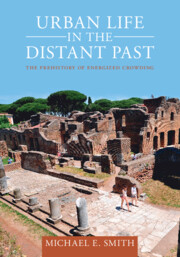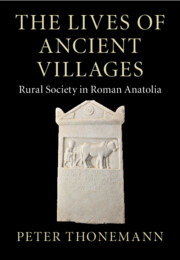23 results
3 - Population, 1000–1500
- from Section II - The Medieval Economy, 1000–1500
-
-
- Book:
- An Economic History of the Iberian Peninsula, 700–2000
- Published online:
- 22 February 2024
- Print publication:
- 29 February 2024, pp 76-101
-
- Chapter
- Export citation
What is a village? Agroscapes, collective action and medieval villages in northern Iberia
- Part of
-
- Article
-
- You have access
- Open access
- HTML
- Export citation
25 - So Many Living Arrangements
- from Part III - Caring For Yourself and Your Family
-
-
- Book:
- The Gift of Aging
- Published online:
- 08 June 2023
- Print publication:
- 08 June 2023, pp 175-180
-
- Chapter
- Export citation
10 - Cadres, Grain, and Rural Conflicts
- from Part III - Legitimacy and Local Agencies
-
-
- Book:
- Revolutionary Transformations
- Published online:
- 06 April 2023
- Print publication:
- 13 April 2023, pp 231-255
-
- Chapter
- Export citation

Urban Life in the Distant Past
- The Prehistory of Energized Crowding
-
- Published online:
- 15 March 2023
- Print publication:
- 30 March 2023
10 - City, Village, Kin-Group
-
- Book:
- The Lives of Ancient Villages
- Published online:
- 28 October 2022
- Print publication:
- 17 November 2022, pp 319-356
-
- Chapter
- Export citation
9 - Village Society
-
- Book:
- The Lives of Ancient Villages
- Published online:
- 28 October 2022
- Print publication:
- 17 November 2022, pp 284-318
-
- Chapter
- Export citation

The Lives of Ancient Villages
- Rural Society in Roman Anatolia
-
- Published online:
- 28 October 2022
- Print publication:
- 17 November 2022
6 - Asia Minor
- from Part II - Regional Perspectives
-
-
- Book:
- The Cambridge Companion to the Ancient Greek Economy
- Published online:
- 21 July 2022
- Print publication:
- 04 August 2022, pp 77-93
-
- Chapter
- Export citation
Prologue - Before and Beyond: Big Things in Tiny Places
-
- Book:
- Earthopolis
- Published online:
- 10 May 2022
- Print publication:
- 09 June 2022, pp 15-28
-
- Chapter
- Export citation
Introduction - Our Urban Planet in Space and Time
-
- Book:
- Earthopolis
- Published online:
- 10 May 2022
- Print publication:
- 09 June 2022, pp 1-14
-
- Chapter
- Export citation
Domestic Architecture at Letchworth (8JE337) and Other Woodland Period Ceremonial Centers in the Gulf Coastal Plain
-
- Journal:
- American Antiquity / Volume 87 / Issue 2 / April 2022
- Published online by Cambridge University Press:
- 23 December 2021, pp. 389-405
- Print publication:
- April 2022
-
- Article
-
- You have access
- Open access
- HTML
- Export citation
5 - Divergence and division
-
- Book:
- Roman Egypt
- Published online:
- 19 August 2021
- Print publication:
- 09 September 2021, pp 225-275
-
- Chapter
- Export citation
14 - Byzantium
- from Part IV - Practice and Organisation
-
-
- Book:
- Political Culture in the Latin West, Byzantium and the Islamic World, c.700–c.1500
- Published online:
- 11 August 2021
- Print publication:
- 26 August 2021, pp 410-455
-
- Chapter
- Export citation
Hidden in plain sight: the archaeological landscape of Mithaka Country, south-west Queensland
-
- Article
-
- You have access
- Open access
- HTML
- Export citation
22 - Rural Actions and Reactions
- from Part Four - Nationwide
-
- Book:
- June Fourth
- Published online:
- 01 April 2021
- Print publication:
- 01 April 2021, pp 195-203
-
- Chapter
- Export citation
10 - Bandits and Peasants in Medieval Japan
- from Part III - Social, Interpersonal and Collective Violence
-
-
- Book:
- The Cambridge World History of Violence
- Published online:
- 13 March 2020
- Print publication:
- 26 March 2020, pp 207-227
-
- Chapter
- Export citation
6 - Atomic Lands: Risks on a Nuclear Frontier
-
- Book:
- Atomic Junction
- Published online:
- 12 September 2019
- Print publication:
- 19 September 2019, pp 139-169
-
- Chapter
- Export citation
10 - Christians for Christians
-
- Book:
- Christianizing Asia Minor
- Published online:
- 07 August 2019
- Print publication:
- 01 August 2019, pp 232-245
-
- Chapter
- Export citation
Chapter 42 - Towns, Villages and the Land
- from Part V - Political and Social Contexts
-
-
- Book:
- Geoffrey Chaucer in Context
- Published online:
- 24 June 2019
- Print publication:
- 11 July 2019, pp 355-362
-
- Chapter
- Export citation



